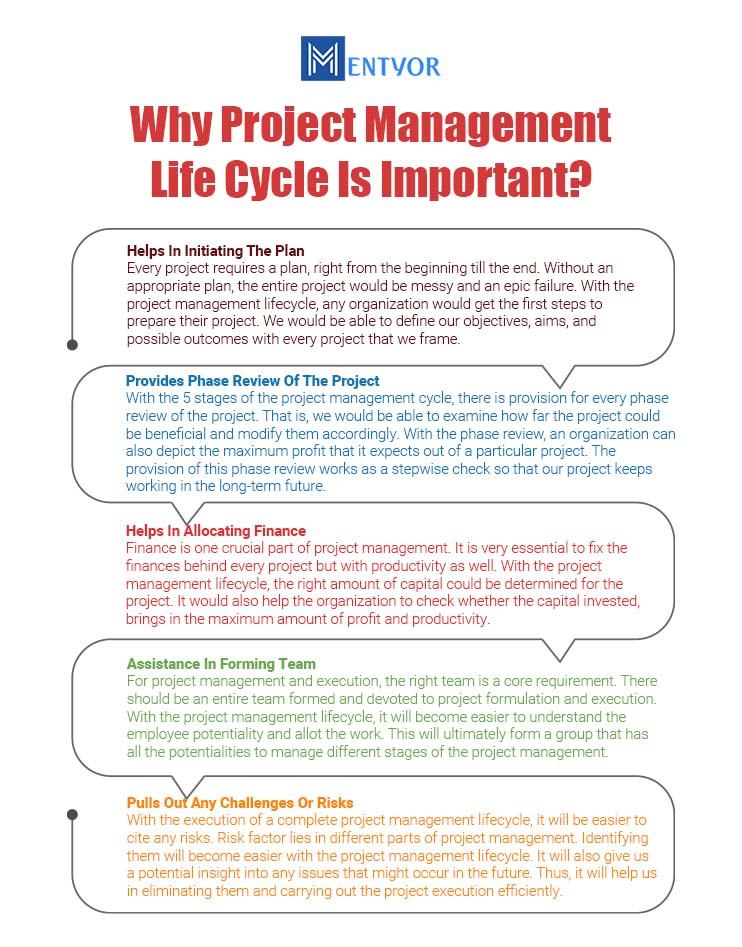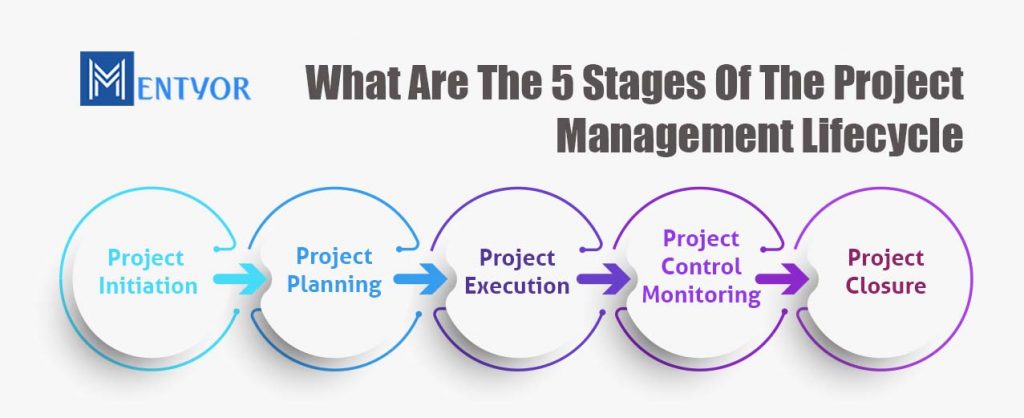Everything has a specific stage and time to bloom. Just like a cocoon takes time to turn into a butterfly, every idea and organization does the same. The field of project management more or less works with the same principle. Application of project management is not one-day execution and successful results. It goes through a series of processes which are broadly named under the shade of project management lifecycle.
This lifecycle is the same across different sectors that use management. This cycle is also termed as 5 stages of the project management lifecycle. Executing this complete lifecycle of project management is essential to determine that the project will be a success in reality.
The importance of the project management lifecycle also lies in the complete utilization of the three elements. These three elements are the core of management. These are people, skills, and technology. A complete lifecycle of project management ensures that the right team, resources, and technological aspects are applied. Before we dive into knowing these 5 stages of project management, we must know what significance it holds. Understanding why the project management life cycle is important is essential to understand each of its stages.
Takeaway
Just like a cocoon takes time to become a butterfly, project management has the same story. It comprises an entire lifecycle to succeed in various sectors. This is broadly named as project management lifecycle. This complete lifecycle of management has become the top priority for various organizations to hold a strong foot in their domain world.
Read our Blog about Supply Chain Management: What Is Supply Chain Management ? [3 Examples + Advantages]
Why Project Management Life Cycle Is Important?

There are a plethora of good reasons why initiating a project management lifecycle will be beneficial for any organization [1]. It not only helps in the successful implication of management but also grows an understanding of how to apply and execute. Below are some handy reasons why the complete lifecycle of project management is useful.
Helps In Initiating The Plan
Every project requires a plan, right from the beginning till the end. Without an appropriate plan, the entire project would be messy and an epic failure. With the project management lifecycle, any organization would get the first steps to prepare their project. We would be able to define our objectives, aims, and possible outcomes with every project that we frame.
Provides Phase Review Of The Project
With the 5 stages of the project management cycle, there is provision for every phase review of the project. That is, we would be able to examine how far the project could be beneficial and modify them accordingly. With the phase review, an organization can also depict the maximum profit that it expects out of a particular project. The provision of this phase review works as a stepwise check so that our project keeps working in the long-term future.
Helps In Allocating Finance
Finance is one crucial part of management. It is very essential to fix the finances behind every project but with productivity as well. With the project management lifecycle, the right amount of capital could be determined for the project. It would also help the organization to check whether the capital invested, brings in the maximum amount of profit and productivity.
Assistance In Forming Team
For project management and execution, the right team is a core requirement. There should be an entire team formed and devoted to project formulation and execution. With the project management lifecycle, it will become easier to understand the employee potentiality and allot the work. This will ultimately form a group that has all the potentialities to manage different stages of the management.
Pulls Out Any Challenges Or Risks
With the execution of a complete project management lifecycle, it will be easier to cite any risks. Risk factor lies in different parts of management. Identifying them will become easier with the project management lifecycle. It will also give us a potential insight into any issues that might occur in the future. Thus, it will help us in eliminating them and carrying out the project execution efficiently.
This is how the application of the project management lifecycle makes our tasks easier. It ensures that no loopholes are left unattended. It also gives a brief demonstration of how our project would work in the future and what precautions we can take.
Takeaway
Project management lifecycle is very beneficial to any organization. It helps in several ways. These are:
- Helps In Initiating The Plan
- Provides Phase Review Of The Project
- Helps In Allocating Finance
- Assistance In Forming Team
- Pulls Out Any Challenges Or Risks
Read how to become Data Scientist 2022: How To Become A Data Scientist In 2022: A Complete Guide To Data Science
What Are The 5 Stages Of The Project Management Lifecycle

Now that we know how significant the project management lifecycle is, it is also important to its stages. There are a total of 5 stages of the project management lifecycle [2]. Applying these 5 stages is essential to complete the entire project management lifecycle. Missing one of them would create a stark interruption in the execution of project.
The 5 stages of the project management lifecycle are Project Initiation, Project Planning, Project Execution, Project Control/Monitoring, and Project Closure. Let us understand these 5 stages with a complete explanation.
Project Initiation
The first phase or stage of the project management lifecycle is project initiation. With its literal meaning, the main essence of this phase is to initiate the project plan. Here, every organization tries to measure the feasibility and value of their project. This is done in and around the objectives laid by the organization. There are two kinds of case studies involved in this stage as well.
These are the business case document and the feasibility study. Under the business case document, the organization tries to determine the need for the project and its financial beneficiaries. Under the feasibility study, the organization tries to conduct a complete evaluation of the project’s goals. There is also an evaluation involved regarding the project timeline and utilization of the available resources.
Project Planning
The second stage for project management is termed project planning. Once the project is initiated, it requires a solidified plan to continue ahead in its execution. In this phase, the team for guiding the project is decided. Along with this, the budget estimation is made and the deadline for the project curation is also fixed. A project plan also consists of what resources will be used and their estimated usage too. It also includes providing a brief direction about the quality of production, risk factors, and further communication between stakeholders. It also prepares the respective team to handle the hurdles and complete the project successfully under the determined timeline.
Project Execution
The third phase or stage for the project management cycle is project execution. After the initiation and plan have been formed, it is time to finally execute the project. This phase is closely linked with the essence of management. In general terms, project management is about the successful execution of the project. In this phase, the organization tries to determine how their project is customer-friendly. It also includes the determination of benefits and deliverable efficacy to the customers. In here, the team members are allocated with their work, and the resources are used accordingly. This phase heavily relies on the project planning phase. The execution will only work efficiently if the planning is made efficiently.
Project Control/Monitoring
The fourth phase of the project management lifecycle is monitoring. This phase is sometimes linked as a simultaneous process for the third phase, which is project execution. Along with the execution, there is also monitoring of the project observed by the involved team. Monitoring is essential for the organization to understand whether the project is meaning significant progress. It also indicates the risk or the obstacle and then helps the team to decide upon the appropriate action. It also helps the team to keep an eye on the financial usage and the key performance indicators. With this phase, the project is ensured to run smoothly without any interference.
Project Closure

The last and final stage or phase of the project management lifecycle is project closure. This stage is also called the adieu stage of a complete lifecycle of management. In this stage, the teams finally end the project after it has served the requisite goals to the users or customers. They also communicate the progress to the stakeholders and finally let go of the resources that were in complete use. This also includes the disintegration of the team after the project is successfully implemented and ended. Additionally, this phase also allows the teams to understand their strengths and weaknesses. This ultimately helps them to shape the next project better and refine it to the best of their abilities.
These are the 5 stages of the project management cycle. Applying these 5 stages can help any organization to succeed with its management plans. It can help them to use all kinds of resources efficiently. Also, these 5 stages of project management provide assurance for the project to run smoothly and for a long period of time.
Data Science Application you need to know: A Digital World: 12 Amazing Data Science Applications
Takeaway
There are 5 stages of project management. These stages make up the entire project management lifecycle. These are:
- Project Initiation
- Project Planning
- Project Execution
- Project Control/Monitoring
- Project Closure
Parting Note
Project management has gained a very popular and useful role in a plethora of organizations. Due to this, the growing understanding of the project management lifecycle has become very important. These 5 stages of project management ensure that all the risks are eliminated. Further, these stages also ensure that there is smooth running for the project. In the management lifecycle, an organization can cover up all the basics required to succeed in a project plan.
The 5 stages of management are project initiation, project planning, project execution, project monitoring/control, and project closure. Passing through these five stages is essential to clear out the bug and keep the project apt and working. Project management lifecycle is an integral part of management. It ensures that nothing goes vague or is left out for the utilization of a particular project.
Common FAQs
- What are examples of PM?
The examples for project management (PM) can range around various sectors. Some of the examples for PM are product launch, marketing strategy, construction of a new school, designing e-learning platforms, etc.
- What is the main purpose of project management?
Project management aims at the achievement of three main purposes. These are:
- Strategizing a prosperous team and using human resources
- Curating the processes, procedures and using technological tools to ream masses.
- Maximizing profit by creating projects that serve the customer’s needs and are used to them.
References
[1] Brotherton, S. A., Fried, R. T., & Norman, E. S. (2008). Applying the work breakdown structure to the project management lifecycle. In PMI Global Congress Proceedings (pp. 1-15).
[2] Westland, J. (2007). The project management life cycle: a complete step-by-step methodology for initiating planning executing and closing the project. Kogan Page Publishers.


 WhatsApp
WhatsApp